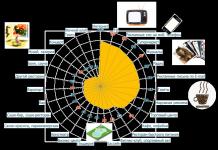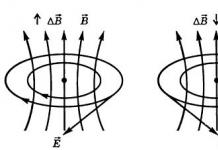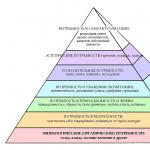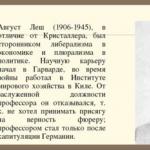Industrial designer is a specialist who studies ready-made market samples and creates a high-quality prototype. The profession is suitable for those who are interested in drawing and drawing (see choosing a profession based on interest in school subjects).
He does not develop innovative products, is not responsible for the quality of designs, but improves items that we use every day.
Brief description
Representatives of this profession must be different mathematical thinking and have a creative approach to work. After all, this specialty combines 3 popular areas:
- marketing;
- art and design;
- modern technologies.
The field combines science and creativity, so to master this profession you need to obtain a higher education.
Features of the profession
In higher education institutions and educational courses, future industrial designers are taught how to create more convenient, beautiful, practical and safe things. Most often, these specialists choose one or several similar areas for themselves, although they can work with different subjects if they have the time and desire to learn.
Direct industrial modeling consists of several stages:
- discussion of the project with the customer;
- thorough study of existing products and all available information about them (3D models, technical documentation, drawings);
- developing a concept and transferring it into sketch format;
- after this the specialist must select necessary materials and technologies for creating a product;
- creation of a 3D model;
- if the customer approves the model, then the process of prototyping and testing begins;
- If there are no problems, the improved product/service is refined, retested, and launched into production.
During these processes, the industrial designer works closely with engineers, marketers, chemists, biologists and other specialists who take part in the project.
The main goal of the work is to create an improved product that will attract consumer interest. It must also be functional, safe and cost-effective.
Pros and cons of the profession
Pros
- Industrial design is one of the highest paying industries in this segment.
- The work is difficult, but quite interesting.
- Career prospects.
- Specialists of this profession are in demand both in Russia and abroad.
- You can get an education in any region of the Russian Federation.
- A representative of the profession examines ready-made products, so he only needs to improve them.
- You can work remotely or in the office, which makes the profession more attractive.
Cons
- The work is nervous, and the specialist is tied to the requirements of the customer and the market.
- The work can take a lot of time, because the customer sets a deadline, and if the designer does not have time, then he will have to work day and night.
- In small towns, it is difficult for a specialist in this profile to find work.
- You need to work a lot at the computer, which can negatively affect your health, in particular your vision.
- You need to constantly improve your knowledge by studying different areas (design, materials science, marketing and others).
Personal qualities
- Creativity and mathematical mind.
- A penchant for analysis.
- Knowledge of a foreign language.
- The desire to understand the intricacies of the product, without losing sight of the little things.
- Ability to work in a team.
- Ability to listen and analyze ideas and comments from colleagues.
- The desire to create something new.
- Minimum knowledge about the field of activity of accountants, because representatives of this profession may be required to draw up estimates and develop a project within strict budget limits.
Industrial designer training
Representatives of this profession must study throughout their lives, but they should start by obtaining higher education in a specialized educational institution (specialty code 54.03.01). The competition is quite large, upon admission you must Unified State Exam results in general education subjects. During admission, you will need to pass an additional exam in the Russian language, social studies and a creative competition, for example, this could be a drawing or composition. Admission conditions depend on the highest educational institution. Form of training: full-time.
In this course, you can obtain the profession of an industrial designer remotely in 1-3 months. Diploma of professional retraining standard established by the state. Training in a completely distance learning format. Largest educational institution additional prof. education in Russia.
Universities
Place of work
Professional industrial designer will find a job at any enterprise that is engaged in the creation of products - these are factories for the production of clothing, furniture, dishes and others. Also, representatives of the profession are in demand in companies that specialize in the development and creation of websites, mobile applications and other types of software.
Remuneration
Salary as of 03/17/2020
Russia 25000—60000 ₽
Moscow 40000—150000 ₽
An industrial designer can be officially employed by a government or private company, he can also look for customers in the domestic and foreign markets, working as a freelancer. Wages specialist depends on his experience and the direction he has chosen (equipment, products for household use, household chemicals and others).
Career
A specialist can gain first experience while working as a freelancer, at the same time he must prepare his own portfolio. After 1-1.5 years, a designer can apply for a solid position and official employment.
This is one of the most successful areas of design, because representatives of the profession can count on career growth. After just a few years of fruitful and quality work an industrial designer can head a department and take the position of creative director, which will have a positive impact on his salary.
Also, designers working in this direction can give lessons and consultations, which can be the first step towards creating your own school.
Lore
A specialist must be able to draw well, using both a regular pencil and modern programs for 3D visualization and design:
- Solid Edge;
- Pro/Engineer and others.
Also, the designer must know everything about computer modeling, types of materials, packaging features different groups goods. It is important to be able to create estimates, correct mistakes of other team members and study technical documentation in a foreign language.
Famous people in this profession
- Victor Papanek.
- Karim Rashid.
- Maarten van Severen.
- Michael Thonet.
- Eero Aarnio.
Industrial designer is a specialist who studies ready-made market samples and creates a high-quality prototype. The profession is suitable for those who are interested in drawing and drawing (see choosing a profession based on interest in school subjects).
He does not develop innovative products, is not responsible for the quality of designs, but improves items that we use every day.
Brief description
Representatives of this profession must be distinguished by mathematical thinking and have a creative approach to work. After all, this specialty combines 3 popular areas:
- marketing;
- art and design;
- modern technologies.
The field combines science and creativity, so to master this profession you need to obtain a higher education.
Features of the profession
In higher education institutions and educational courses, future industrial designers are taught how to create more convenient, beautiful, practical and safe things. Most often, these specialists choose one or several similar areas for themselves, although they can work with different subjects if they have the time and desire to learn.
Direct industrial modeling consists of several stages:
- discussion of the project with the customer;
- thorough study of existing products and all available information about them (3D models, technical documentation, drawings);
- developing a concept and transferring it into sketch format;
- after this, the specialist must select the necessary materials and technologies to create the product;
- creation of a 3D model;
- if the customer approves the model, then the process of prototyping and testing begins;
- If there are no problems, the improved product/service is refined, retested, and launched into production.
During these processes, the industrial designer works closely with engineers, marketers, chemists, biologists and other specialists who take part in the project.
The main goal of the work is to create an improved product that will attract consumer interest. It must also be functional, safe and cost-effective.
Pros and cons of the profession
Pros
- Industrial design is one of the highest paying industries in this segment.
- The work is difficult, but quite interesting.
- Career prospects.
- Specialists of this profession are in demand both in Russia and abroad.
- You can get an education in any region of the Russian Federation.
- A representative of the profession examines ready-made products, so he only needs to improve them.
- You can work remotely or in the office, which makes the profession more attractive.
Cons
- The work is nervous, and the specialist is tied to the requirements of the customer and the market.
- The work can take a lot of time, because the customer sets a deadline, and if the designer does not have time, then he will have to work day and night.
- In small towns, it is difficult for a specialist in this profile to find work.
- You need to work a lot at the computer, which can negatively affect your health, in particular your vision.
- You need to constantly improve your knowledge by studying different areas (design, materials science, marketing and others).
Personal qualities
- Creativity and mathematical mind.
- A penchant for analysis.
- Knowledge of a foreign language.
- The desire to understand the intricacies of the product, without losing sight of the little things.
- Ability to work in a team.
- Ability to listen and analyze ideas and comments from colleagues.
- The desire to create something new.
- Minimum knowledge about the field of activity of accountants, because representatives of this profession may be required to draw up estimates and develop a project within strict budget limits.
Industrial designer training
Representatives of this profession must study throughout their lives, but they should start by obtaining a higher education at a specialized educational institution (specialty code 54.03.01). The competition is quite large; for admission, Unified State Examination results in general education subjects are required. During admission, you will need to pass an additional exam in the Russian language, social studies and a creative competition, for example, this could be a drawing or composition. Admission conditions depend on the higher education institution. Form of training: full-time.
In this course, you can obtain the profession of an industrial designer remotely in 1-3 months. Diploma of professional retraining established by the state. Training in a completely distance learning format. The largest educational institution of additional professional education. education in Russia.
Universities
Place of work
A professional industrial designer will find work in any enterprise that creates products - these are factories for the production of clothing, furniture, dishes and others. Also, representatives of the profession are in demand in companies that specialize in the development and creation of websites, mobile applications and other types of software.
Remuneration
Salary as of 03/17/2020
Russia 25000—60000 ₽
Moscow 40000—150000 ₽
An industrial designer can officially find employment in a public or private company, and he can also look for customers in the domestic and foreign markets, working as a freelancer. The salary of a specialist depends on his experience and the direction he has chosen (equipment, products for household use, household chemicals and others).
Career
A specialist can gain first experience while working as a freelancer, at the same time he must prepare his own portfolio. After 1-1.5 years, a designer can apply for a solid position and official employment.
This is one of the most successful areas of design, because representatives of the profession can count on career growth. After just a few years of fruitful and high-quality work, an industrial designer can head a department and take the position of creative director, which will have a positive impact on his salary.
Also, designers working in this direction can give lessons and consultations, which can be the first step towards creating your own school.
Lore
A specialist must be able to draw well, using both a regular pencil and modern programs for 3D visualization and design:
- Solid Edge;
- Pro/Engineer and others.
The designer must also know everything about computer modeling, types of materials, and packaging features for different groups of products. The ability to create estimates, correct mistakes of other team members, and study technical documentation in a foreign language is important.
Famous people in this profession
- Victor Papanek.
- Karim Rashid.
- Maarten van Severen.
- Michael Thonet.
- Eero Aarnio.
There are countless professions in the world of design, and one of the most versatile, interesting and multifaceted is an industrial designer. Such specialists are responsible for creating everything around them: equipment, furniture, household items, dishes, cars, yachts and even mobile applications.
If you manage to combine logical thinking and creativity, and the thirst to make this world a little better and more beautiful does not leave for a minute, which means you should think about a career in the field industrial design. For such work it is required vocational training, which implies obtaining a Bachelor's or Master's degree.
The Marangoni Institute offers specialized education in the Bachelor's program "Industrial Design" and Master's program "Vehicle Design" and "Italian Industrial Design". During their studies, students: study the history of art; learn to develop ideas for new products and create them; delve into the business component of the industry in order to not only come up with something beautiful, but in demand and in line with the latest or future trends. Upon graduation, they are 100% ready to work and begin successful career on the international market.
But before you apply for admission, let's find out about this promising profession a little more.
Features of work
Typically, industrial designers specialize in one product or service. Although there are no frames or boundaries, it all depends on the desire to learn and develop in different directions. The only thing that is mandatory for everyone is to create products that meet the requirements: easy to use, function well, cost-effective to produce, attractive appearance.
Depending on the project, the scope of work may vary, but the main tasks of an industrial designer are:
discussing with the client his wishes and drawing up a brief;
- studying the operation of existing products and services;
- development of ideas, initial drawings and sketches;
- making a choice decision suitable materials and resources;
- computer modeling of the product and creation of detailed drawings;
- production of prototypes;
- testing a product or service;
- final development and launch of production.
At all stages of work, the designer must interact with engineers, modelers, marketers and other members of the development team.
Working hours and income
Most often, such specialists work according to a standard schedule from 9.00 to 18.00 (30-40 hours per week), although creative process sometimes it takes extra time.
In Europe, beginning designers can earn from 15 to 22,000 euros per year, more experienced ones 25-34,000, and “experienced” salaries start from 42,000 euros.
Training and professional development
We already wrote above that to work you need to get an education. But having a diploma does not negate continuing education. Industrial designers must be lifelong learners: taking advanced training courses, completing highly specialized programs, reading magazines, books, websites and blogs. It is worth joining design associations and attending specialized exhibitions and events.
Skills, interests and personal qualities
- creative ideas and a logical approach for their development;
- ability to express ideas through drawings and 3D models;
- understanding properties various materials and production methods;
- ability to plan and organize a project at all stages;
- ability to create cost estimates and work within budget;
- good communication skills;
- ability to write clear and concise reports;
- creative approach to problem solving;
- ability to work in a team and exchange ideas with colleagues.
Possibilities
Industrial designers are in demand in a wide range of industrial and commercial fields. For example, they work as part of a new product development team in toy factories or furniture production. They can also act as consultants or collaborate with a variety of brands on a freelance basis.
By gaining work experience, industrial designers have the opportunity to become creative director or head the project management department. Modern technologies brought this profession to new level with knowledge of ergonomics, functionality and external beauty product, designers can work on developing mobile applications and websites. More and more of them are contributing to the online world and becoming UX designers.
You can find out more about studying Bachelor's and Master's programs in industrial design at the Marangoni Institute from the consultants of the official representative office -
The concept of industrial design is relatively new, but has already gained popularity among many modern people. We can say that this is a synthesis of science and art, the main purpose of which is to improve external qualities items.
An interview with Sebastian Bergne will help you become more familiar with the features of industrial design and understand all the intricacies of this field. This phenomenon is distinguished by its originality, which attracts many people.
Areas of activity
The main purpose of design is to change objects, installations and objects that have been produced in the industrial sector. This solution has a beneficial effect on life and comfort, and brings real aesthetic pleasure.
Industrial designers are constantly developing original and unique things that also have functionality.
The main leading countries in this area include:
- Italy;
- France;
- Japan;
- Holland.
Industrial design deals with design in areas that produce technological equipment, vehicles, and create communications.
This list can include architectural styles and interior design. Medical installations are also covered by industrial design work.

People involved in industrial design prefer natural and quality materials. The correct shape of objects and precise geometry are fundamental factors in creating a project.
Designers transform ordinary and familiar objects into original things that become unique goods, one of a kind.
Project development includes the following features:
- design creation is based on modern trends;
- the specialist must take into account the convenience and safety when using the item;
- during development, it is necessary to remember to comply with the wishes of the buyer;
- the principle and concept of the company must be respected.
When creating a project, specialists take into account large number factors. An item or system should not only be attractive and laconic in appearance, but also have maximum functionality.
Before manufacturing an object, designers create a 3D model, which helps to draw attention to all the advantages and disadvantages.
Watch industrial design from draft to product in the video:
The phrase “industrial design” is now heard by many people. But the idea of what it is is completely different for everyone. Industrial design is the same type of creative activity as ordinary design, but the objects of industrial design are most often industrially manufactured household products.
Manufacturing companies today have to resort to various tricks in order to withstand competition and adequately present their product on the market. consumer market. Interesting and high-quality design of an industrial product - effective way stand out among competitors and interest consumers. The purpose of industrial design is to define the exterior, structural and functional features objects to which industrial design techniques are aimed. Industrial design items include dishes and other kitchen utensils, household and industrial appliances, furniture, equipment, and even high-tech and knowledge-intensive products. Industrial design options include today's popular automotive and transportation designs.
Thus, industrial design is not only the art of combining design with technology, but also a marketing tool.
A professional who creates a design for an industrial product must be at the same time an artist, a designer, and a process engineer. After all, industrial design requires using your creative imagination so that the technological meaning of the final product is not violated.
The artistic design process itself consists of 8 stages:
Formation of the main idea
Concept development
Working with sketches
Layout
3D modeling
Visualization
Engineering design
Creation of a prototype
The professional’s task is to guide the industrial design object through the preliminary seven stages so that the eighth production stage proceeds without delay and produces the final result in accordance with the main idea.
Copyright for the design concept and basic ideas of an industrial product belongs to the designer, except as otherwise specified in the contract. In accordance with Article 27 of the “Law of the Russian Federation on Copyright and Related Rights No. 5351-I”: copyright is valid during life and 70 years after his death; copyright, the right to name and protection of reputation are preserved indefinitely. In addition, the designer has the right to display original works in a portfolio in order to attract the attention of new customers.
The emergence of design
The emergence of design special type design and artistic activity dates back to the end of the 19th century, linking its appearance with the industrial revolution - the widespread development of mass machine production and the division of labor that arose as a result. In the conditions of industrial production and the filling of the market with goods, the attention of manufacturers was increasingly drawn to the attractiveness and variety of appearance of manufactured products, as well as to the consumer qualities of products and ease of use. As a result, a need arose for a special specialist capable of not only creating an attractive appearance that meets fashion trends and consumer needs, the shape of the product, but also a good understanding of design and machine production technology. Only in the context of solving complex engineering and technical problems, artistic issues It is possible, as practice has shown, to create competitive products.
The whole story industrial design is closely related to the history of technology development. Inventions such as steam boiler, engine internal combustion, electric motor, aeronautics created not only new areas in mechanical engineering, but also steel historical stages in the development of design.
The 19th century was a century of stunning progress. One technical miracle replaced another; the century that began with stagecoaches and the quill pen ended with the automobile and the typewriter. The telegraph was followed by the telephone, then the “wireless telegraph” - radio. People came up with a way to make accurate images from nature, without an artist, record and preserve the human voice for centuries, made the first attempts to fly on a device heavier than air, and invented moving photography - cinema.
The work of a craftsman, the process of creating the shape of an object, was directly related to its manufacture. With the advent of the age of industrialization, prototypes of products began to be created in the form of drawings, models and prototypes, which were then produced in numerous editions using machines by other people. Thus, at the turn of the century, in the process of industrial production, a division of labor occurred, design emerged as a separate form of design and artistic activity and began to take shape new profession- designer.
Design as a profession has existed for about a hundred years. It often starts with the famous movement “For the Connection of Arts and Crafts” in England late XIX c., whose leader was famous artist and subject matter theorist William Morris. It was then that the basic principles of the theory and creative principles of design were formulated, which influenced the schools and trends of later years. Sometimes the date of the emergence of the design profession is associated with the beginning of the 20th century, when artists took leading positions in a number of industrial sectors and had the opportunity to shape the corporate style of enterprises, influencing the policy of shaping the products produced by companies. As examples, the corporate styles of the German electrical engineering company AEG and the American automobile company Ford Motor are given. There is also an opinion that we can talk about design as a profession only when schools with methods for teaching design have emerged and the first certified design specialists have appeared. This is the 20s of our century, when the first design schools were opened - Bauhaus - in Germany and VKHUTEMAS - in Soviet Russia. There is also a point of view according to which the emergence of design is attributed to the period of the global crisis of 1929; it is described primarily as an American phenomenon.
Indeed, until the crisis of 1929, European design remained a purely local phenomenon, without having a noticeable impact on industrial production. And only with the beginning of the crisis American design becomes a real commercial force, gradually acquiring in every sense This word is widespread, and a professional design industry is emerging. The new style direction of Functionalism, which was formed at the beginning of the century in the architecture of America and a number of European countries, became a kind of theoretical basis for the development of the principles of form-building in design. Its leaders, who saw the beauty of artistic form in its functional expediency, stood at the origins of machine-based design. Among them are: famous names like Louis Sullivan, one of the founders of the Chicago School of Architecture, famous for its buildings of the “machine age”; Frank Lloyd Wright - patriarch of American architecture and design; Peter Behrens is a German architect and artist, whose name is associated with an entire era in the development of design and, in particular, the emergence of a “corporate style”; Mies van der Rohe is one of the leaders of the famous German industrial union Werkbund and the founders of rationalist architecture and design in Germany; Walter Gropius - founder of Bauhaus, a world-famous school modern architecture and design; Gerit Thomas Rietveld is a Dutch architect whose conceptual “red and blue chair” has become a sculptural symbol of modern design.
Among the pioneers of design were architects and modernist artists who came to industry. Representatives of Art Nouveau were looking for a way out of the impasse of boring imitation of the styles of the past, they rejected eclecticism, sharply criticized decoration and ornamentation, and searched in the field of rational, geometric shapes, special attention while paying attention to beauty source material, identifying it. In essence, these views were a kind of step towards the philosophy of industrial formation. Among them are such famous names as Henri Van de Velde, whose name is associated with the emergence of the Art Nouveau style, Michael Thonet and his world-famous “Viennese chair”; Charles Mackintosh - Scottish architect, leader of the Art Nouveau style, whose design is considered one of the pinnacles of European Art Nouveau and his turn-of-the-century furniture is reproduced to this day; Raymond Lowy - one of the founders professional design in the US, he is often called the father of industrial design; Camillo Olivetti and Erwin and Arthur Brown, whose names are associated with entire styles in the history of design; Giovanni Ponti - Italian architect - founder of the most famous design magazine "Domus"; Alvar Aalto - the founder of modern Finnish architecture and design; as well as our compatriots - K. Malevich, A. Rodchenko, V. Tatlin, L. Lisitsky and others, who became the origins of Soviet design.
In our country, until recently, the following terms were used to denote the concept of “design”: “artistic design” - the design process, “industrial art”, “technical aesthetics” - the field of activity. And the specialist designer was called “artist-designer”, the leading design institute was the All-Union Scientific Research Institute of Technical Aesthetics, and the most popular in the 60-80s. domestic design magazine - “Technical Aesthetics”.


















